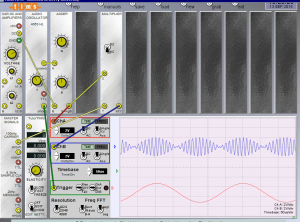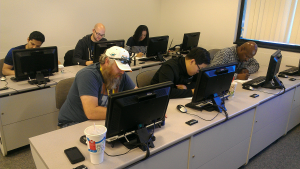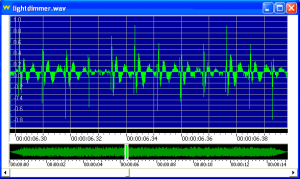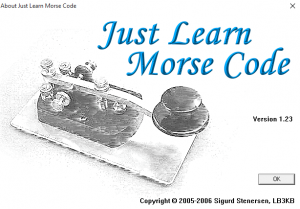DeVry University Biomedical Engineering Students Learn CW as Part of Telemedicine Curriculum
October 30, 2015
Fremont, CA
The President of the San Francisco Bay Area DeVry University Campus lingered in the doorway of our classroom. She was fascinated yet at the same time annoyed by the blaring sound of Morse code at 16 WPM reverberating throughout the hallways. She watched my students furiously scribbling meaningless strings of letters on notepads and eventually pulled our classroom door closed. (Her office is located directly across from our classroom – I should have anticipated that problem)
How did CW find its way into a DeVry University class room?
CW Never Dies
I am a software developer in the San Francisco Bay Area, a Ham (KT8E) and a member of MARCO. My father is a Ham (4X1LL) and MARCO member as well. I was visiting my Dad last month and out of the blue he asked me if I was working any CW and did I miss it. I have not worked CW lately and I realized that I did miss it. And that planted the seed for an interesting classroom experience.
DeVry University has a long history of revolutionizing education in the electronics field. Over 50 years ago, I sat in the shack with my Dad while he pored over his mail-order DeVry electronics course. Each week, a package would arrive with a workbook and parts. The final project for the course was building an oscilloscope from a kit. Dad is color blind and my job was to read the resistor color codes. That is how I got hooked.
Fast forward to today. As part of my consulting business, I hire student interns from the ranks of DeVry. They are pretty smart kids and cheap labor. My affiliation as an employer evolved into a visiting professorship teaching electronics and biomedical technology courses. BMET 436 is a course that focuses on Tele-Medicine – the delivery of healthcare at a distance. The course includes a series of lab exercises addressing wireless communication and signal modulation.
No Substitute for Hands-on Experience
Education has changed since I was in college. In my day, we wired up scopes, VOMs, signal generators and power supplies with lots of cables. At DeVry, the lab experience has shifted towards virtualization. Students use “virtual” instruments to build signal generators, filters and modulators. Below is a snapshot of a virtual instrument demonstrating AM modulation.

TutorTims Virtual Instrumentation
Illustrating AM Modulation
One of the topics discussed is signal-to-noise ratio and how it impacts the reliability of intelligence modulating a carrier signal. While virtual instruments are interesting and have a place in the curriculum, in my mind there is no substitute for hands-on experience. To illustrate the impact of signal-to-noise on radio transmissions, I thought of the efficiency of CW and how well the intelligence propagates in noisy conditions.
I approached this in two steps. The first step was to teach a few letters of Morse code to the students until they reached a reasonable degree of proficiency. The second step was to mix various types of QRN with the CW and measure how their proficiency was impacted.
The Morse Code Trainer
I used a Windows program written by LB3KB called, “Just Learn Morse Code” which employs Koch’s method and Farnsworth timing.
Koch’s method — Traditionally, Morse code has been taught by struggling through all the codes at a slow speed and then (slowly) progressing towards higher speeds. Koch’s method, on the other hand, dictates that you should start learning at the desired speed – but you start with only two characters. Each session is five minutes long, and whenever you get 90% or more correct, you add another character.
Farnsworth timing — Reducing the speed of Morse code has been done by making everything take longer, i.e. both the sounds and the silent periods between them. Using Farnsworth timing, characters are sent at the same speed as at higher speeds, while extra spacing is inserted between characters and words to slow the transmission down. The advantage of this is that you get used to recognizing characters at a higher speed, and thus it will be easier to increase the speed later on.
We used the software for a series of training sessions that spanned two days of class. Within that time, the students were able to copy one minute straight at 16WPM of the letters “K”, “M”, “R”, “S” and “U” with an accuracy of 90% or better.

DeVry students learning to copy CW
ARRL Sounds of RFI
The second part of this exercise was to mix audio from the CW trainer with various forms of RFI. This was easy to do by saving audio sequences from the code trainer in WAV file format and mixing them with WAV files that reproduce various types of RFI. These files can be found on the ARRL web site at http://www.arrl.org/sounds-of-rfi. The types of QRN include:
- Household RFI
- RF Emitters
- Computers
- Electric Utilities
- Miscellaneous RFI Sources
 S
S
ample of Noise from a Light Dimmer
The CW audio level was mixed with the different QRN audio levels at a ratio of 50-50, i.e., the magnitudes of the audio sources were equal.
The Results of Our Experiment
There was no appreciable decline in the students’ accuracy scores when copying code from the trainer with and without the QRN mixed in the audio. Students experienced the ease with which CW can be copied reliably under noisy conditions. In future experiments, I hope to try:
- Decreasing the signal to noise ratio of CW to QRN to determine at what point students’ accuracy diminishes.
- Mixing QRN with other types of signal modulation (such as AM or sideband) to illustrate how noise impacts communications with wider bandwidths.
Conclusion
CW continues to play a vital role in radio communications and served us well as an educational tool in this biomedical course. And if the aliens do invade (shades of Independence Day), CW will save the planet hi.

Dave, KT8E
References:
The following link was contributed by Corrine Kimball as part of her Famous Inventors and Inventions technology class project:
All About the Telegraph and Deciphering Morse Code Text
Introduction to Biomedical Equipment Technology Fourth Edition by Joseph J. Carr, John M. Brown © 2001, by Prentice-Hall, Inc., Upper Saddle River, New Jersey 07458
TutorTims
© 2004 – 2011 Emona Instuments Pty Ltd.
www.webtims.com

Just Learn Morse Code
© 2005 – 2006 Sigurd Stenersen, LB3KB
www.justlearnmorsecode.com

Sounds of RFI
http://www.arrl.org/sounds-of-rfi

http://www.devry.edu/